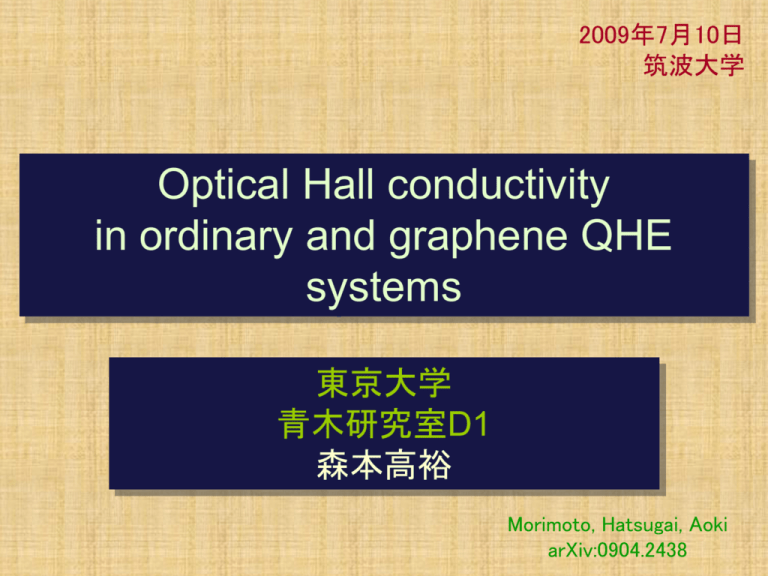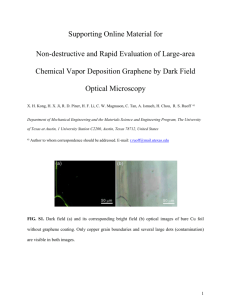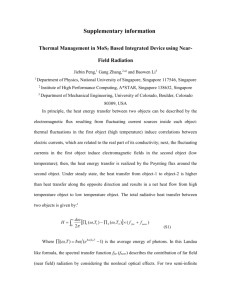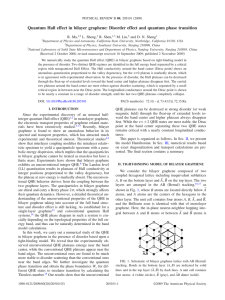optical s xy - 初貝研究室
advertisement

2009年7月10日 筑波大学 Optical Hall conductivity in ordinary and graphene QHE systems 東京大学 青木研究室D1 森本高裕 Morimoto, Hatsugai, Aoki arXiv:0904.2438 Electronic structure of graphene Effective Hamiltonian Tight binding approx. A B Massless Dirac quasiparticles Dirac QHE sxy rxx 10 μm (Geim et al, Nature Mat. 2007) (Novoselov et al, Nature 2005; Zhang et al, Nature 2005) 2 /16 Purpose B Static transport properties of QHE systems are established. How about dynamical properties ? Development of THz spectroscopy (Komiyama et al, PRL 2004) (Sumikura et al, JJAP, 2007) (Ikebe, Shimano, APL, 2008) Anomalous QHE in graphene (Novoselov et al, Nature 2005; Zhang et al, Nature 2005) (Sadowski et al, PRL 2006) The focus is optical properties of QHE systems: (Morimoto, Hatsugai, Aoki ●Cyclotron emission in graphene ・・・ sxx PRB 2007) 3 /16 ●Faraday rotations in QHE systems ・・・ sxy (to be published) THz spectroscopy of 2DEG (Ikebe, Shimano, APL, 2008) Resonance structure at cyclotron energy Ellipticity Faraday rotation (Sumikura et al, JJAP, 2007) 4 /16 ac Hall effect sxy (w) ● For ordinary 2DEG, Faraday rotation measurement for THz w (Sumikura et al, JJAP, 2007; Ikebe, Shimano, APL, 2008) ● Optical (ac) Hall conductivity sxy (w) for ordinary QHE systems So far only treated with Drude form (Sumikura et al, JJAP, 2007) (O'Connell et al, PRB 1982) for graphene QHE systems ● sxy (w) calculated with Kubo formula 5 /16 (Exact diagonalisation) Effects of localization 2DEG Effects of localization was significant for static Hall coductivity sxy (w=0) (Aoki & Ando 1980) localization length DOS How about for optical sxy (w) ? Various range of impurities Short range : charged centers Long range : ripples of graphene optical sxy (w) : Exact diagonalization (ED) for long-ranged random potentials 6 /16 In clean limit… ●ac Hall conductivity from Kubo formula ●How does dc Hall plateau structure evolve into ac region? Clean ordinary QHE system step structure resonance structure Hall step structure in the clean limit How about with disorder? Is it robust? 7 /16 Static Hall conductivity and Localization Scaling behavior of Thouless energy impurity Localization length (K. Nomura et al, PRL, 2008) Robust n=0 Anderson transition 8 /16 Formalism ●Diagonalization for randomly placed impurities (H0+V) 9 Landau levels retained ~5000 configurations Strength of disorder G: (Landau level broadening) Free Dirac Hamiltonian +B Impurity potential whose range d ~ magnetic length Optical Hall conductivity from Kubo formula for T=0 9 /16 Optical conductivity for graphene QHE -12 01 12 G=0.2 Step structure in both static and optical region 01 G=0.5 Plateau structure remains up to ac region (at least resonace?) 10 /16 Results for Usual QHE system Step structure in both static and optical region 12 01 G=0.2 DOS does not broaden uniformly for LLs G=0.7 Plateau structures seem to be more robust than in graphene. Difference of universarity classes 11 /16 Plateau in sxy (w) (ordinary QHE) ac step structure a remnant of QHE remain for moder disorders 12 /16 Plateau in sxy (w) (graphene QHE) w = 1.5wc G = 0.2 w = 0.9wc w = 0.4wc w=0 ac step structure as a remnant of QHE remain for moderate disorders 13 /16 Estimation of Faraday rotation Faraday rotation ∝ optical Hall conductivity (O`Connell et al, PRB 1982) (Nair et al, Science 2008) Step structure cause jumps of Faraday rotation by n0: air, ns: substrate exp quite feasible! Faraday rotation ~ fine structure constant: “a seen as a rotation” Resolution ~ 1 mrad in Ikebe, Shimano, APL, 2008) 14 /16 Kubo formula, Localization, Robust step (Aoki & Ando 1980) Main contribution comes from transitions between extended states Extended states reside in the center of LL as in the clean sample Contribution from extended states reproduce the clean limit result step structure resonance structure Robust Hall step structure from ED calculation Localization and delocalization physics as in dc Hall conductivity? 15 /16 Summary – ac Hall effects ● step structures in optical Hall condcutivity ac Hall effect ● effects of localization and robustness of plateau structures ● estimated the magnitude of Faraday rotation and experimentally feasible □Future problems ● honeycomb lattice calculation ●dynamical scaling arguments of sxy (w) -12 01 12 16 /16





